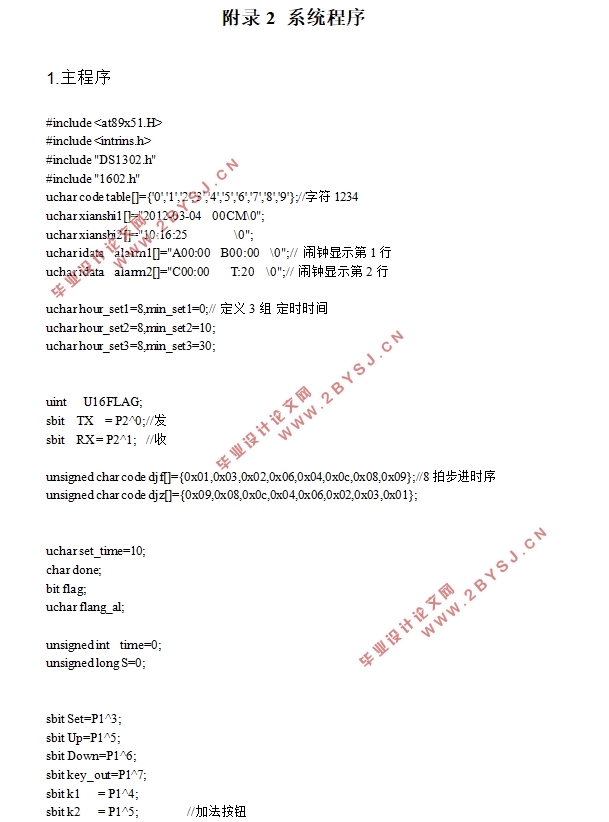基于单片机的智能喂食系统设计(附主程序代码,实物图)
无需注册登录,支付后按照提示操作即可获取该资料.
基于单片机的智能喂食系统设计(附主程序代码,实物图)(任务书,开题报告,论文12000字)
摘 要
时代的发展,经济的增长,饲养宠物的人数日益上升。传统意义上的宠物饲养用作陪伴玩耍,在这种方式下人们对宠物健康的重视程度往往不够。同时,家人们聚少离多,这时候宠物会发生一种情感寄托的作用,但是主人忙碌的时候就可能顾不上宠物的喂食,因而,本文设计一种可以在无人操控的情况下智能投食的系统,可以定时给留在家中的宠物喂食,并且该系统要具备一定的稳定性和有效性。
本文主要是设计基于单片机的智能喂食系统,并完成相应的硬件制作。基于单片机的智能喂食系统,主要有定时、定量和投食等电路组成,预先设置好每餐的食物量,按照宠物的具体状态设置喂食时间,但是我们得提前训练宠物适应机器喂食,以免宠物不适应而错过进食。系统还可以检测食物量,通过计算得出食物剩余量。当添加食物或食物添加完毕时,以及系统检测到食物剩余量不足时,可以及时发出警报信号。宠物在我们身边是随处可见的,但是宠物喂食器大家使用得并不多,如果这一技术得到推广,可以有效保护宠物健康成长。
事实证明,该设计实用性很强,简洁方便。本文通过这次研究,使用超声波测距传感器来测量食物余量,时钟芯片控制定时信号,输出给单片机,经过处理后,单片机控制步进电机进行喂食操作。在进行喂食的过程前后,以及超声波传感器测量到食物剩余量为0时,皆会发出报警信号。报警系统由二极管和蜂鸣器模拟实现。可是,想要完美地呈现出实物,还需要结合机械方面的知识,本文在这方面的准备稍有逊色,希望在以后的研究中,可以进一步结合多方面的知识,运用到实际应用中来改善人们的生活质量。
关键词:单片机 仿真设计 串口通讯 智能控制
Intelligent feeding system based on single chip microcomputer
Abstract
With the development of the times and the growth of economy, the number of pets is increasing day by day. Traditionally, pet farming is used as a companion to play, and in this way, people are often less concerned with pet health. At the same time, family members together from many, this pet will have a role in emotional sustenance, but when the owner busy could not attend to pet feeding, therefore, the design of a system in the case of unmanned intelligent feeding, can be timed to stay at home in the pet food, and this system will have a certain stability and validity.
This article mainly designs the intelligent feeding system based on single chip microcomputer, and completes the corresponding hardware manufacture. Intelligent feeding system based on single chip, the main timing, quantitative and feeding circuit, a preset amount of food for each meal, set feeding time according to the specific state of the pet, but we have to adapt to the machine training pet feeding, lest pet to wrong after eating. The system can also measure the amount of food and calculate the amount of food remaining. When food or food is added, and when the system detects insufficient food supplies, an alarm signal can be issued in time. Pets can be found everywhere, but pet feeders are not used very much. If this technology is popularized, it can effectively protect the healthy growth of pets.
Facts have proved that the design is very practical, concise and convenient. Through this research, to measure the food allowance using ultrasonic ranging sensor, clock chip timing control signal output to the microcontroller after processing, MCU control stepper motor for feeding operation. An alarm signal is issued before and after the feeding process, and the ultrasonic sensor measures the amount of food remaining at 0. The alarm system is simulated by diode and buzzer. However, you want the perfect show real, but also requires a combination of mechanical knowledge, in the preparation of this slightly inferior, hope in future research, can be further combined with the knowledge in many aspects, with the practical application to improve the quality of people's lives.
Key words:MCU, simulation design, serial communication, intelligent control


目 录
基于单片机的智能喂食系统 I
摘 要 I
第一章 绪论 1
1.1 课题研究的背景和意义 1
1.2 智能系统的发展现状 1
1.3 课题研究的主要内容 1
第二章 智能喂食系统的主要功能和方案设计 3
2.1主要功能和设计方案 3
2.1.1智能喂食系统的主要功能 3
2.1.2智能喂食系统的方案设计 3
2.2智能喂食系统的整体方案 4
2.2.1智能喂食系统的工作原理 4
2.2.2智能喂食系统的整体硬件框图 4
2.3器件的选择 5
2.3.1主控芯片的选择 5
2.3.2时钟芯片的选择 5
2.3.3 显示屏的选择 6
2.3.4 喂食模块的选择 6
2.3.5传感器模块的选择 7
第三章 智能喂食系统的硬件电路设计 8
3.1 单片机最小系统 8
单片机在启动时都需要复位,以使CPU及系统各部件处于确定的初始状态,并从初态开始工作,本设计中使用P0口的数据I/O口功能[12],用于连接LCD1602的使能端;P3口一般作第二功能使用,本设计中使用串口功能,用于喂食模块。 8
3.1.1晶振电路 8
3.1.2复位电路 8
3.2 时钟电路设计 9
3.3 LCD显示电路 11
3.4 按键电路设计 11
3.5蜂鸣器和指示灯电路设计 12
3.6喂食电路的设计 13
3.8传感器电路设计 13
第四章 智能喂食系统的软件设计 15
4.1软件流程设计 15
4.1.1总体程序流程设计 15
4.1.2传感器测距流程设计 16
4.1.3 喂食程序流程设计 17
4.1.4 时钟芯片程序流程设计 18
4.1.5 LCD显示程序设计 18
第五章 智能喂食系统的硬件调试 20
5.1 硬件系统调试 20
5.1.1调试过程 20
5.1.2调试结果 21
5.1.3本设计存在的不足 22
结 语 24
参考文献 25
附录1 整体电路 26
附录2 系统程序 27
1. 主程序 27
2. 时钟子程序 45
3.显示子程序 47
